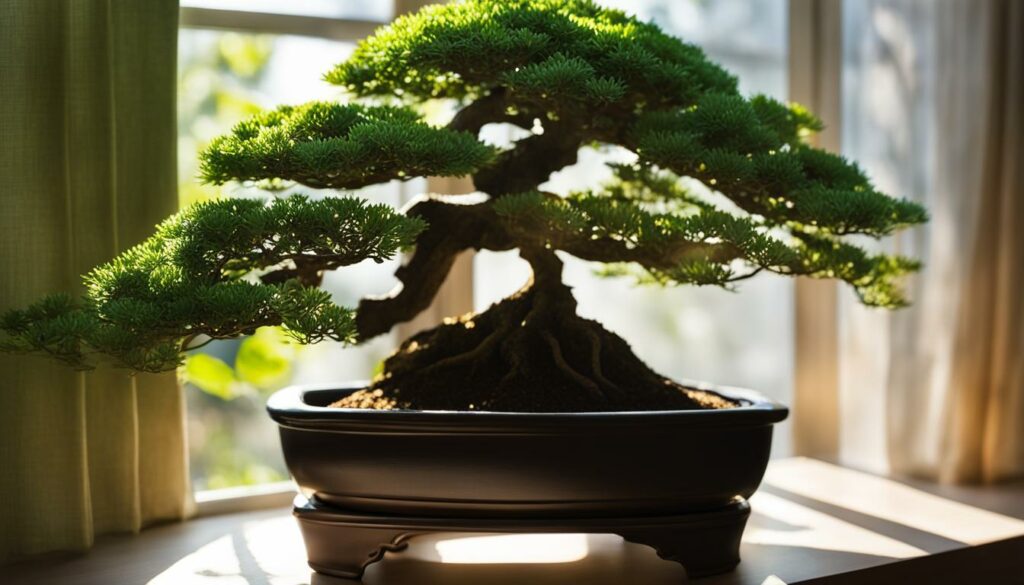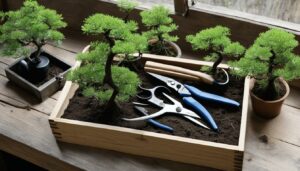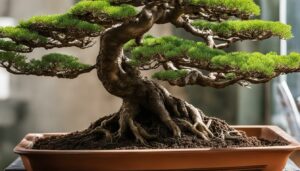For the bonsai enthusiast, knowing about bonsai sunlight needs is as crucial as understanding the nuances of pruning or watering. These miniature trees encapsulate the beauty of nature within a compact form, but their vibrancy and health are heavily dependent on one key aspect: light requirements. As you delve into the realm of bonsai care, you’ll quickly discover that sun exposure is not just a detail—it’s an essential ingredient for the life of your indoor bonsai or garden centerpiece.
Selecting the correct bonsai placement is more than just a matter of décor; it involves a thoughtful consideration of sunlight patterns and intensity. The ever-changing dance of light throughout the day requires your attention to ensure your bonsai thrives.
Key Takeaways
- Understanding bonsai sunlight needs is fundamental for their health and aesthetic appeal.
- Both outdoor and indoor bonsai require specific light requirements to flourish.
- Optimal bonsai placement involves observing and catering to the unique sun exposure each plant needs.
- The right balance of sunlight can affect the vigor and visual beauty of your bonsai.
- Being aware of the sunlight intensity throughout the day helps in positioning your bonsai perfectly.
Understanding Your Bonsai’s Sunlight Requirements
The light requirements of your bonsai are as pivotal for its health and vibrancy as water and soil. Each bonsai species has unique needs that, when properly met, contribute to the full expression of its inherent beauty. By understanding the bonsai sunlight needs, you can create an environment that supports robust bonsai health and fosters growth.
It’s essential to note that not all bonsais require the same amount of light. The duration of sunlight exposure your bonsai needs can greatly influence its ability to photosynthesize effectively and maintain a balanced growth pattern.
- Full-sun species typically thrive with around six hours of direct sunlight per day.
- Partial-sun bonsais prefer a mix of sun and shade, benefitting from filtered light or a few hours of direct sun.
- Shade-loving bonsais require protection from the intense midday sun to avoid leaf scorch.
The quality of light is also a determining factor for the health of your bonsai. While natural sunlight is ideal, not all environments can provide this consistently. In such cases, it’s possible to supplement with artificial light sources designed to mimic the full spectrum of natural light.
A balanced approach to sunlight can prevent common issues such as wilting, yellowing of leaves, or stunted growth. The following table offers insights into typical light requirements for various popular bonsai species:
| Bonsai Species | Sunlight Requirements | Notes |
|---|---|---|
| Juniper | Full sun | Requires around 6 hours of direct sunlight daily. |
| Ficus | Partial sun | Can tolerate lower light; consider morning sun with afternoon shade. |
| Pine | Full sun | Thrives in ample sunlight; perfect for outdoor display. |
| Maple | Partial to full sun | Protect from strong afternoon sun to prevent leaf burn. |
| Azalea | Partial sun | Avoid hot, direct sunlight; prefers bright but indirect light. |
In summary, understanding the amount and type of sunlight your bonsai needs is essential for its well-being. Tailoring the light exposure to suit your specific bonsai will contribute to a healthier and more aesthetically pleasing plant. As a bonsai enthusiast, continue to observe and adjust the light conditions for your bonsai, ensuring that it receives the perfect amount of sunlight to thrive.
The Importance of Sun Exposure for Bonsai Health
Proper sun exposure is essential for the health of your bonsai, playing a pivotal role in photosynthesis—a process that fuels plant growth and vitality. Without sufficient light, a bonsai can struggle to produce the energy it needs, leading to a range of growth-related issues. Let’s explore how sunlight impacts your bonsai and what signs to look out for that indicate your tree may not be basking in enough natural light.
Photosynthesis and Growth
Photosynthesis in bonsai is the magical process where sunlight is transformed into chemical energy. This process not only drives growth but also contributes to the development of rich, green foliage and the bonsai’s ability to store energy for less sunny days. The right balance of sun exposure ensures that your bonsai efficiently synthesizes food for sustained health and development.
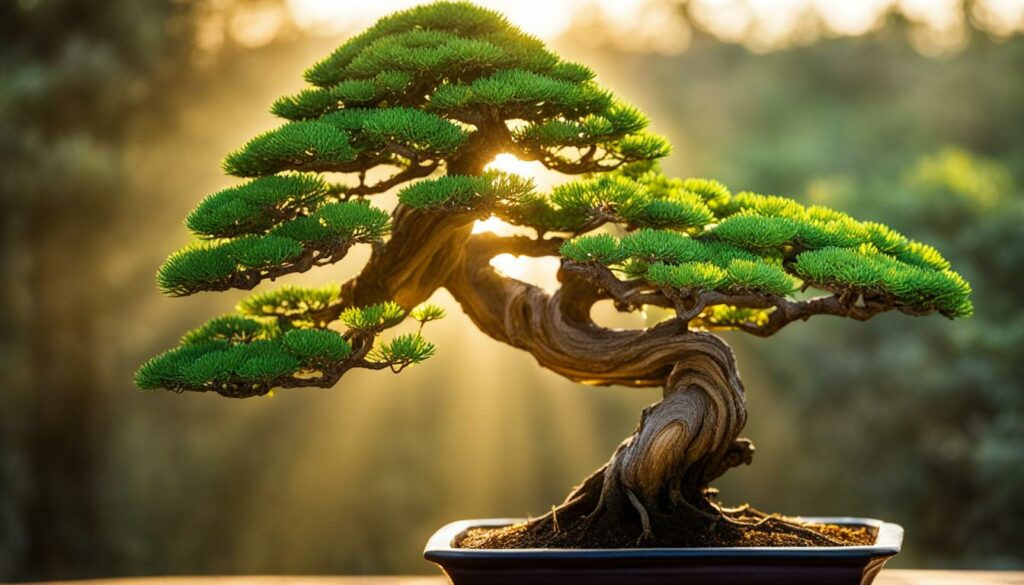
Identifying Signs of Inadequate Light
Recognizing the signs of inadequate light is key to preventing long-term damage to your bonsai. Some common symptoms include:
- Weak Growth: Your bonsai may appear stunted, with new shoots struggling to mature.
- Elongated Leaves: A clear indication that your bonsai is reaching for more light.
- Lack of Flowering: If your bonsai is of a flowering variety but fails to produce blooms, it might be craving more sunshine.
- Pale or Yellowing Leaves: Insufficient light can lead to a lackluster appearance in the foliage.
By monitoring these signs and ensuring your bonsai receives optimal sun exposure, you can maintain its health and encourage robust growth.
Selecting the Best Placement for Bonsai Sunlight and Positioning
Finding the ideal placement for bonsai within your living space or garden involves more than just picking a sunny spot and calling it a day. It is a nuanced decision that takes into account a variety of factors, including light intensity, duration of sunlight, and the need to protect the delicate tree from harsh direct sunlight that could be more harmful than beneficial.
Bonsai placement in relation to sunlight and positioning doesn’t have to be a gamble. Start by observing the patterns of light that traverse through your potential bonsai spaces. Does morning light bathe the eastern side, with gentle rays that invigorate without overwhelming? Or, perhaps, the western exposure brings a harsher, more intense end-of-day sunlight that could lead to leaf scalding. These observations will dictate the ideal positioning within your chosen environment.
When indoors, the proximity to windows plays a key role. A south-facing window can offer a steady supply of sunshine but may require shielding during peak hours. Conversely, a north-facing window might necessitate supplemental lighting. Sunlight and positioning impact not just growth but also the artistic appearance of your bonsai, making it all the more vital to get right.
- Inspect potential locations at different times of the day to understand the light quality and duration.
- Consider the season, as the angle of the sun changes, affecting the intensity of exposure.
- Balance the bonsai’s need for sunlight with the potential risk of overheating and drying out.
Remember that each bonsai species has its unique requirements, and what’s ideal for one may be detrimental to another. Therefore, knowledge of your particular bonsai’s needs, paired with these general principles, will lead you to select the best placement that encourages a harmonious blend of health, growth, and artistic beauty.
Indoor Bonsai Light Requirements
As you delve into the art of indoor bonsai care, it is crucial to understand the specific light requirements that these miniature trees demand. Adequate lighting not only ensures your bonsai’s vitality but also contributes to the intricate beauty that makes these plants such exceptional living sculptures.
Artificial Light Options for Indoor Bonsai
Should natural light be insufficient in your home, artificial light for bonsai becomes essential. Artificial lighting like grow lights can effectively supplement or even replace sunlight, offering a spectrum of light that supports the growth and health of your indoor bonsai. Balanced light spectrums promote proper photosynthesis and can even spur flowering and fruiting in some bonsai species.
When selecting grow lights, consider LED or fluorescent options as they are energy-efficient and run cooler, reducing the risk of leaf burn.
Window Direction and Light Intensity
The direction your windows face significantly affects the light intensity and quality your indoor bonsai will receive. Here’s a quick guide to help you understand how window orientation impacts sunlight exposure:
| Window Direction | Light Quality | Bonsai Considerations |
|---|---|---|
| North | Low | Ideal for shade-tolerant species |
| South | High and direct | Mostly suit sun-loving bonsai; may require shading |
| East | Gentle morning light | Provides a balanced option for many bonsai |
| West | Intense afternoon sun | Can lead to overheating; sun might need to be diffused |
Remember, your indoor bonsai’s location can make the difference between a thriving plant and one that struggles. Monitor the light throughout the day to ensure your bonsai receives the optimal balance for its species.
Paying attention to window direction light intensity and utilizing artificial light for bonsai when necessary will provide your indoor bonsai with the energy it needs to be a healthy and enchanting part of your living space.
Outdoor Bonsai and Natural Sunlight Benefits
As an outdoor bonsai enthusiast, you’re in the fortunate position to leverage the full spectrum of natural sunlight, which brings a multitude of benefits to your miniature trees. However, outdoor conditions present unique challenges, particularly when it comes to sunlight exposure and seasonal considerations. To help you maximize the health and beauty of your bonsai collection, here are key insights into adapting to the shifting patterns of the great outdoors.
Seasonal Considerations for Outdoor Bonsai
Seasonal changes can dramatically affect the amount of sunlight your outdoor bonsai will receive. During the spring and summer months, your bonsai may revel in longer daylight hours, but keeping an eye on the intensity of the sun is crucial to prevent scorching. Conversely, in fall and winter, you may need to find ways to maximize light exposure to compensate for shorter days.
| Season | Sunlight Exposure | Care Adjustments |
|---|---|---|
| Spring | Increasing daylight | Gradually introduce to more sunlight; monitor water needs |
| Summer | High intensity | Provide some shade during peak hours; ensure adequate hydration |
| Fall | Decreasing light | Move to a brighter location if necessary; start preparing for dormancy |
| Winter | Lowest intensity and duration | Maximize light where possible; protect from extreme cold |
Adjusting to Outdoor Sunlight Exposure
Giving your bonsai a healthy transition outdoors involves more than simply placing them outside. It’s essential to acclimate your bonsai to prevent shock from sudden changes. Start with a shaded area and gradually move your bonsai into more direct sunlight, allowing it to adjust over a period of two to three weeks. This method helps in avoiding stress and gives your tree the opportunity to adapt to its new environment seamlessly.
Monitoring your outdoor bonsai regularly will provide valuable feedback. Look for cues such as leaf color and pliability, soil moisture levels, and the robustness of new growth. By being attentive, you can alter the sunlight exposure accordingly, ensuring your bonsai receives just the right amount to thrive, no matter the season.
How to Protect Bonsai from Excessive Sunlight
Caring for your bonsai involves not just nurturing it, but also safeguarding it from the harsh effects of too much sun. Excessive sunlight can lead to sunburned leaves, a weakened structure, and even the rapid dehydration of your treasured plant. To protect bonsai from potential sun damage, understanding and prevention are key. Let’s dive into how you can shield your bonsai without cutting off its vital sunlight supply.
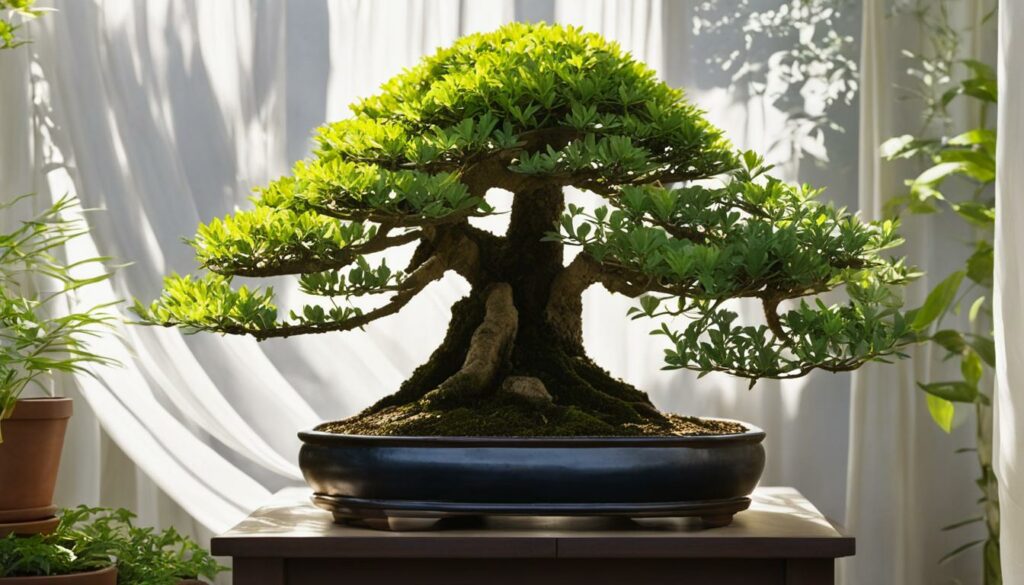
- Discolored or crispy leaves
- Leaves that curl or droop unnaturally
- Dry, brittle branches and soil
- Stunted growth or loss of foliage
To safeguard against excessive sunlight, consider these strategic measures:
- Position your bonsai in a spot where it receives gentle morning light but is shielded from the more intense afternoon rays.
- Use a sheer curtain or blind to diffuse strong direct sunlight when grown indoors near windows.
- During peak summer months, consider moving your bonsai to a location that receives partial shade, especially in the hot afternoon.
- Implement a shade cloth outdoors to create a barrier between your bonsai and the sun, without completely blocking out light.
- Incorporate a timed watering system to ensure consistent moisture levels, especially on hotter days.
By remaining vigilant and responsive to the signs of sun damage, and employing these measures to prevent excessive sunlight exposure, you can ensure that your bonsai continues to grow healthily and beautifully.
Maximizing Growth: Balancing Sunlight and Shade
As a bonsai enthusiast, achieving the fine line between light and shadow can greatly influence the vitality of your miniature tree. The secret to maximizing growth lies not just in bathing your bonsai in sunlight but in skillfully managing the interplay of sunlight and shade balance. Striking this balance requires an understanding of light patterns and the expertise in creating shade for bonsai, which helps prevent stress while encouraging healthy development.
Understanding Light Patterns
Every bonsai has its unique rhythm with the sun. As it moves throughout the day, patterns emerge, revealing areas of intense light and profound shade. These patterns fluctuate with the seasons, requiring you to observe and adapt to ensure your bonsai receives the ideal amount of sun. Tracking this carefully can prevent the risk of excessive exposure while providing your bonsai with the energy it needs.
Creating Shade for Your Bonsai
Strategically creating shade can protect your bonsai from harsh midday sun or the burning touch of summer afternoons. Whether through the placement of screens, the use of taller plants, or the incorporation of adjustable shading structures, controlling the intensity and duration of sunlight plays a pivotal role in promoting a thriving bonsai habitat.
| Time of Day | Sunlight Quality | Shade Strategy |
|---|---|---|
| Morning | Soft, Warm Light | Minimal Shade |
| Midday | Intense, Direct Sun | Moderate to Heavy Shade |
| Afternoon | Harsh, Strong Light | Light to Moderate Shade |
| Evening | Dimming, Cooler Light | No Shade Necessary |
By attentively adjusting your bonsai’s exposure to sunlight as per the table above, you’ll avoid the common pitfalls of overexposure while also preventing your bonsai from languishing in gloom. With attentive care, the contrast of light and shadow will not only enhance your bonsai’s aesthetic appeal but also contribute to an ideal growth environment.
Tips for Monitoring and Adjusting Bonsai Sunlight Levels
For the avid bonsai caretaker, understanding and monitoring sunlight levels is essential. Achieving the right amount of bonsai sun exposure can be the difference between a thriving miniature tree and one that struggles to grow. Here are some practical tips to ensure your bonsai receives the optimal amount of light.
Shade Cloths: A shade cloth is a handy tool for adjusting sunlight intensity. On days where the sun is harsh, a cloth with the right density can protect your bonsai from scorching while still allowing through sufficient light.
Movement and Rotation: Consider the sun’s path when placing your bonsai. By moving and rotating your plant throughout the day, you can balance the sun exposure on all sides, promoting even growth and preventing lopsided development.
Seasonal Changes: As seasons transition, so does the sun’s arc. Pay attention to the shifting patterns of light and adjust your bonsai’s position accordingly, either bringing it closer to or further from your light source.
- Identify the sunniest spot in your space and note how it changes with the seasons.
- Invest in a light meter to take the guesswork out of measuring light levels.
- Keep a bonsai journal, noting the effects of different lighting conditions on your tree’s health.
| Season | Light Intensity | Duration | Adjustment Strategy |
|---|---|---|---|
| Spring | Moderate | Increasing | Gradually introduce to longer daylight |
| Summer | High | Longest | Use shade cloths during peak hours |
| Fall | Decreasing | Reducing | Adjust for earlier sunsets |
| Winter | Low | Shortest | Maximize exposure during available hours |
By paying attention to the needs of your bonsai and responding to its delicate cues, you can ensure your treasured tree not only survives but flourishes under your devoted care.
Remember, just like us, bonsai trees need a balanced diet of sunlight to be at their best. With the right touch, your bonsai will illustrate the artistry of nature within the confines of your home or garden.
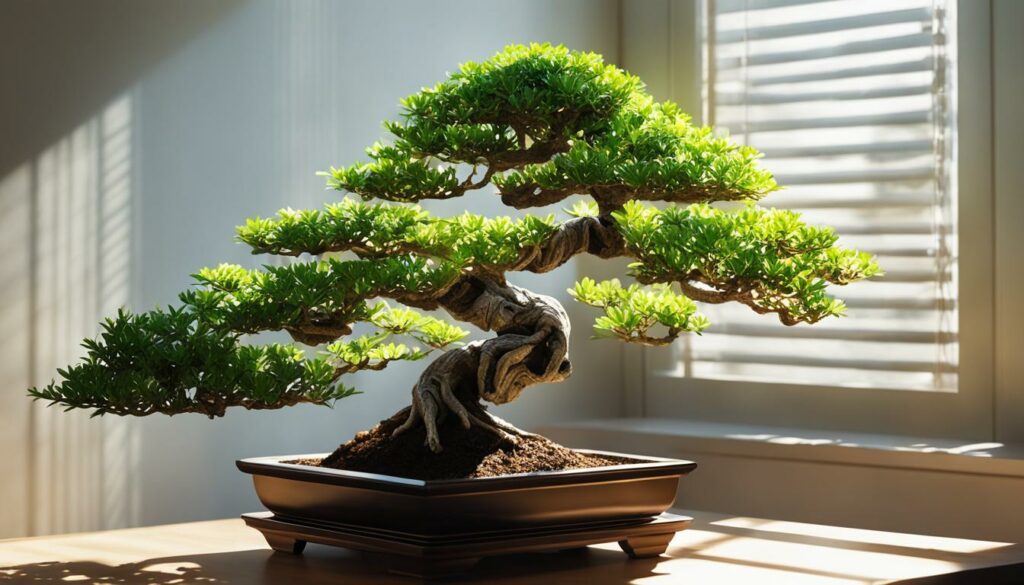
Determining the Unique Light Needs of Different Bonsai Species
Every bonsai tree is a living sculpture, affected by its environment, with light playing a pivotal role in its growth and beauty. As you cultivate your bonsai, understanding the light needs of bonsai species becomes critical. While the art of bonsai is flexible, the science behind its care is precise, requiring species-specific knowledge and an ability to adapt to changing conditions.
Species-specific Sunlight Recommendations
Bonsai species hail from a variety of climates, each with unique light preferences. For instance, a Japanese Maple may thrive with only moderate sunlight, while a Juniper can bask in full sun. Below is a table displaying species-specific sunlight recommendations to guide you in maximizing the potential of your bonsai.
| Bonsai Species | Ideal Sunlight Conditions | Notes on Sunlight Adaptability |
|---|---|---|
| Ficus Bonsai | Indirect, bright light | Can tolerate lower light; avoid direct, intense sun. |
| Pine Bonsai | Full sun | Requires plenty of sunlight to develop dense foliage. |
| Azalea Bonsai | Partial shade | Sensitive to strong, midday sun which can damage leaves. |
| Maple Bonsai | Filtered sunlight, avoid harsh afternoon sun | Leaves can burn if exposed to strong direct sunlight. |
As your bonsai grows and seasons change, adapting its position to maintain optimal light exposure is essential. A well-lit environment can prevent issues such as leggy growth and pale leaves, which indicate a lack of sufficient light.
Adapting to Your Bonsai’s Changing Light Requirements
Just as a young tree matures in nature, your bonsai may experience shifts in its light requirements. Factors such as the age of the plant, the current season, and the denseness of foliage all influence how much light is needed. Here’s where the finesse of bonsai care shines—adapting light requirements to your bonsai’s life stage and seasonal changes is vital for long-term health.
Avoid keeping your bonsai in a static environment; observe and respond to its growth patterns. Consider gentle transitions between seasons, such as moving your bonsai to a brighter spot in winter when natural light is less intense. Remember, the ultimate goal is to emulate the natural conditions your bonsai would experience in its native habitat.
To ensure the best care for your cherished bonsai, continually research its species-specific needs, observe its reaction to different light conditions, and be willing to adjust its position as it grows. This diligent attention to light will reward you with a thriving bonsai that embodies balance and harmony.
Seasonal Sunlight Strategies for Bonsai Care
As a dedicated bonsai enthusiast, you understand the delicate balance required in bonsai care. With each season, your approach to ensuring your miniature trees receive adequate sunlight must adapt. The art of sunlight adaptation is not just about maintaining the right conditions, but also about embracing the changing needs your bonsai may have as the days grow shorter or longer.
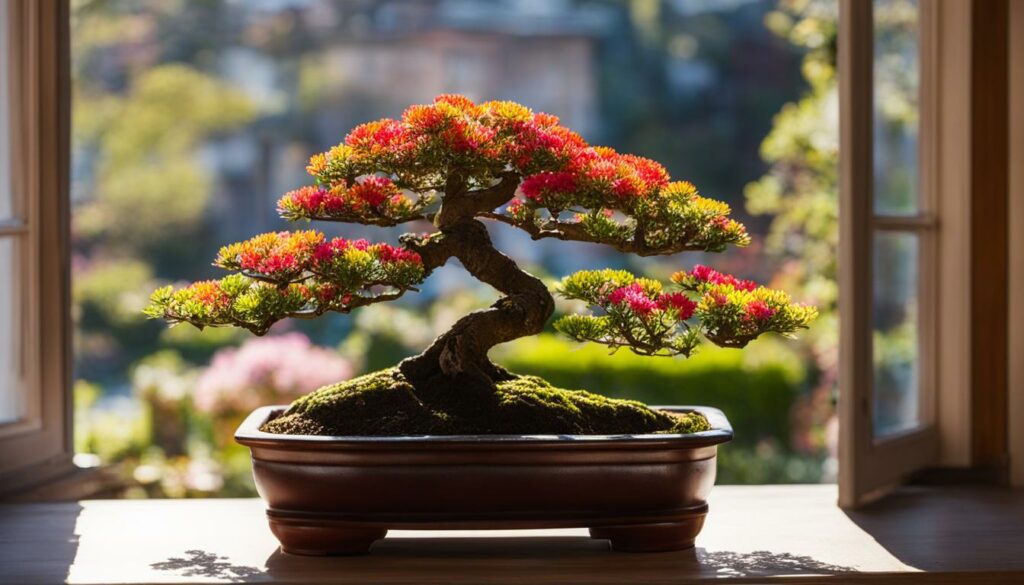
The angle of the sun shifts throughout the year, and so should the position of your bonsai. Here’s a seasonal guide to help you adjust your seasonal sunlight strategies to provide the best care:
- Spring: This is a period of robust growth for most bonsai trees. Increasing daylight stimulates new foliage and flower buds, so ensure your bonsai gets plenty of indirect light.
- Summer: The intensity of the sun’s rays can be harmful during peak summer months. Aim to protect your bonsai from harsh midday sun, possibly positioning it in a spot that receives morning sunlight and afternoon shade.
- Fall: As the sun’s intensity wanes, reposition your bonsai to take advantage of the diminishing light. This is also a good time to prepare for the dormancy period by gradually reducing sunlight exposure.
- Winter: The scarcity of light during winter can be challenging. Place your bonsai in an area where it can enjoy the maximum available sunlight, and consider supplemental lighting if necessary.
Don’t forget, though, that these strategies will differ based on your specific environment and the type of bonsai you are nurturing. Monitoring your bonsai’s response to these adjustments is crucial. Look for vibrant leaves and a healthy growth pattern as signs that your seasonal sunlight strategies are on point.
Positioning Your Bonsai: Practical Considerations
When it comes to nurturing a bonsai, the artful harmony between health and aesthetic requires mindful bonsai positioning. How you employ space utilization can significantly impact not only the vitality of your bonsai but also how it enhances your living or working environment. Let’s explore the best practices for displaying your bonsai and ensuring it receives consistent sunlight exposure.
Space Utilization and Bonsai Display
To maximize the aesthetic appeal of your bonsai while considering its growth needs, strategic space utilization is key. Each bonsai has its own personality which can be accentuated through thoughtful placement in your space. Whether showcased on a dedicated stand or as part of a group arrangement, bonsai display should marry form and function, ensuring that the plant’s individuality shines without compromising its sunlight needs.
Consider the following table for balancing bonsai display with practical positioning:
| Bonsai Type | Recommended Positioning | Considerations for Sunlight Exposure | Display Tips |
|---|---|---|---|
| Coniferous Bonsai | Outdoor garden or balcony | Full sun for most of the day; avoid intense midday heat | Pair with rocks or water elements to simulate natural habitat |
| Flowering Bonsai | Bright indoor space or shaded outdoor area | Bright indirect light; shield from harsh direct sunlight that can damage blossoms | Use contrasting colors for pots to complement the flowers |
| Deciduous Bonsai | Next to a south-facing window or in a light-filled atrium | Consistent light exposure throughout the changing seasons | Arrange with other deciduous varieties to create a mini woodland scene |
| Tropical Bonsai | Indoor terrarium or greenhouse with controlled environment | Warm, humid conditions with plenty of diffused natural light | Incorporate a humidity tray to enhance the microclimate |
Maintaining Consistent Exposure Through the Day
Artfully displayed bonsai must also receive consistent sunlight exposure to maintain their well-being. Ensure your bonsai shifts gradually through different light intensities by changing its position as the day progresses, or by using sheer curtains to modulate the light flow. This steady stream of light mirrors the natural environment where trees evolve and is crucial for balanced growth.
Observing how the sunlight moves across your space will guide you in crafting a rotating schedule for your bonsai display. Adding rotations or slight adjustments to your bonsai’s positioning can significantly contribute to its growth while still serving as the dynamic centerpiece of your space.
Remember, the synergy between bonsai display beauty and practical bonsai positioning can elevate both the health of your bonsai and the elegance it adds to your surroundings.
Common Mistakes When Placing Bonsai in Sunlight
Every bonsai enthusiast understands that sunlight is a pillar in the growth and flourishing of bonsai trees. However, in your quest to provide your bonsai with its much-needed sun, you may inadvertently fall prey to some common mistakes in bonsai placement. Let’s shed light on these sunlight errors and guide you to better care practices.
Frequent errors stem from either overexposure or underexposure to sunlight. While the intentions are to create an environment where bonsai trees can thrive, taking either extreme can stress the plant, inducing symptoms that spell trouble for your miniature green friend.
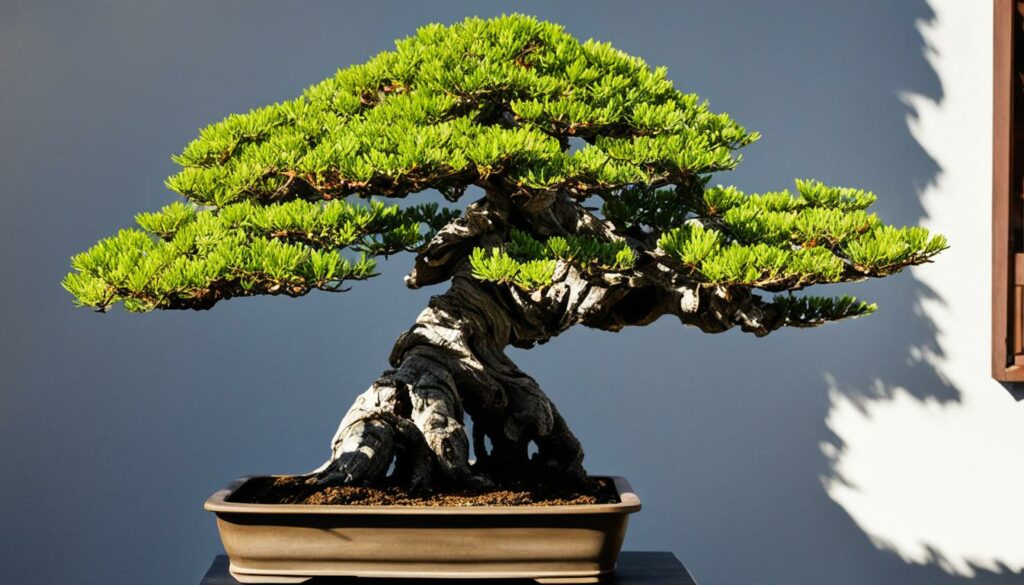
Here’s a list of mistakes that you, as a bonsai caretaker, might be making:
- Placing the bonsai in direct sunlight during the hottest part of the day can lead to scorched leaves and dehydration.
- Keeping the bonsai in the same spot all year round without considering the changing intensity and angle of the sun through the seasons can cause inconsistent growth patterns.
- Underestimating the light needs of indoor bonsais, leading to insufficient growth and a weak structure.
- Assuming all bonsai species have the same sunlight requirements, neglecting the nuances each species brings to light care.
- Forgetting to rotate the bonsai, which results in one-sided growth that can unbalance the aesthetic and health of the tree.
To sidestep these avoidable pitfalls, consider these solutions:
- During summer or high-heat periods, position your bonsai in a spot that enjoys morning light but is protected from the harsh afternoon sun.
- Observe how the sunlight shifts throughout the year and adjust the bonsai’s location accordingly to give it the best possible light exposure without overdoing it.
- Incorporate artificial lighting such as grow lights to supplement natural light for indoor bonsais, ensuring they receive adequate light throughout the day.
- Learn about your specific bonsai’s needs—understanding that a shade-tolerant Ficus will have different needs than a sun-loving Juniper can prevent many common errors in placement.
- Make a habit of rotating your bonsai every few weeks to encourage symmetrical growth.
Being mindful of these common mistakes and employing thoughtful strategies will help you master the art of bonsai placement. This thoughtful approach ensures your bonsai doesn’t just survive, but thrives in its environment, displaying the splendor and harmony that makes bonsai cultivation so rewarding.
Conclusion
As we have traversed the invigorating path of bonsai care, one truth remains clear—the prosperous growth of these living sculptures hinges on a deep understanding of bonsai sunlight needs. Your journey with each bonsai, whether situated within the tranquility of an indoor environment or basking in the splendor of the outdoors, relies heavily on optimizing bonsai placement. This is not just about aesthetics; it’s about ensuring that every ray of light contributes to the vibrancy and vitality of your bonsai.
Those who cultivate indoor bonsai care must navigate unique challenges, wielding the power of both natural and artificial lights to mimic the bonsai’s natural habitat. Conversely, enthusiasts who nurture outdoor bonsai growth attune themselves to the rhythms of the sun and seasons, adapting and evolving just as their bonsai does. In both realms, the essence of bonsai mastery lies in your attentiveness to and harmony with the natural world.
Your dedication to learning and applying the insights on sunlight exposure, positioning, and protection fosters an environment where bonsai trees not only survive but thrive. By embracing these principles, you are equipped to cultivate a garden of miniature wonders—an embodiment of nature’s grandeur and your own horticultural artistry.
FAQ
How much sunlight do bonsai trees need?
Bonsai trees require different amounts of sunlight based on their species, but generally, most bonsai need about 5-6 hours of sunlight daily. It’s essential to understand your specific bonsai’s light requirements for optimal health and growth.
What happens if my bonsai doesn’t get enough sun?
Inadequate sunlight can lead to a variety of issues including weak growth, stretched and elongated leaves, loss of leaf color, and a lack of flowering or fruiting. Ensuring proper light is crucial for maintaining a healthy bonsai.
Can indoor bonsai receive too much sun?
Yes, indoor bonsai can be exposed to too much sun, especially if placed near windows that magnify sunlight. This can lead to leaf scorch or dehydration. It’s important to monitor sunlight exposure and provide shade if necessary.
What are the risks of placing a bonsai in direct sunlight?
Direct sunlight, especially during the hottest part of the day, can burn the leaves and damage the delicate branches of a bonsai tree. Protection from intense midday sun is vital, especially in hot climates.
Can artificial light be used for indoor bonsai trees?
Yes, artificial light such as fluorescent or LED grow lights can be used to supplement natural sunlight for indoor bonsai trees, especially when they are not able to receive enough daylight indoors.
How should I adjust bonsai light exposure throughout the year?
Seasonal changes in the sun’s position and daylight duration require adjustments to bonsai light exposure. During summer, you may need to provide more shade, while in winter, you may need to maximize light exposure. Rotating the plant and changing its position can help ensure even light distribution throughout the year.
How do I protect my bonsai from excessive sunlight and heat?
To protect your bonsai from excessive sunlight and heat, use protective screens or filters, position it in a spot that receives morning sun and afternoon shade, or move it to a semi-shaded area during the hottest parts of the day.
How important is the window direction for placing an indoor bonsai?
Window direction is crucial for indoor bonsai as it affects light intensity and duration. South-facing windows typically receive the most light, followed by east or west-facing windows. North-facing windows receive the least, and may not be suitable for trees requiring high light levels.
What are common mistakes to avoid with bonsai sunlight placement?
Common mistakes include exposing the bonsai to too much direct sunlight, not providing enough light, and failing to adjust placement according to seasonal changes. Overlooking the specific light needs of your bonsai species can also lead to poor growth and health.
Why is it important to create shade for my bonsai?
Creating shade is important to prevent sunburn, dehydration, and heat stress. It helps to manage light intensity and provides a healthier growing environment for bonsai trees, contributing to their overall well-being and aesthetic appeal.
Can bonsai trees adapt to both indoor and outdoor environments?
Many bonsai trees can adapt to both indoor and outdoor environments when acclimated properly. Gradual exposure to different conditions is key to successfully transitioning bonsai between indoor and outdoor settings.
Are there species-specific recommendations for bonsai sun exposure?
Yes, there are species-specific recommendations for bonsai sun exposure. Tropical species generally require more sunlight, while subtropical and temperate species may require a balance of sun and shade. It’s crucial to research and follow guidelines for your particular bonsai species.
How do I maintain consistent sunlight exposure for my bonsai throughout the day?
To maintain consistent sunlight exposure, you can rotate your bonsai periodically to ensure all sides receive light, strategically place it to catch the sun’s path, or consider a mobile stand to move it throughout the day as needed.
How do seasonal sunlight strategies impact bonsai care?
Seasonal sunlight strategies are vital for bonsai care, as they adapt to the varying intensity and duration of sunlight throughout the year. Proper adaptation ensures your bonsai receives the right amount of light while being protected from extreme weather conditions.
